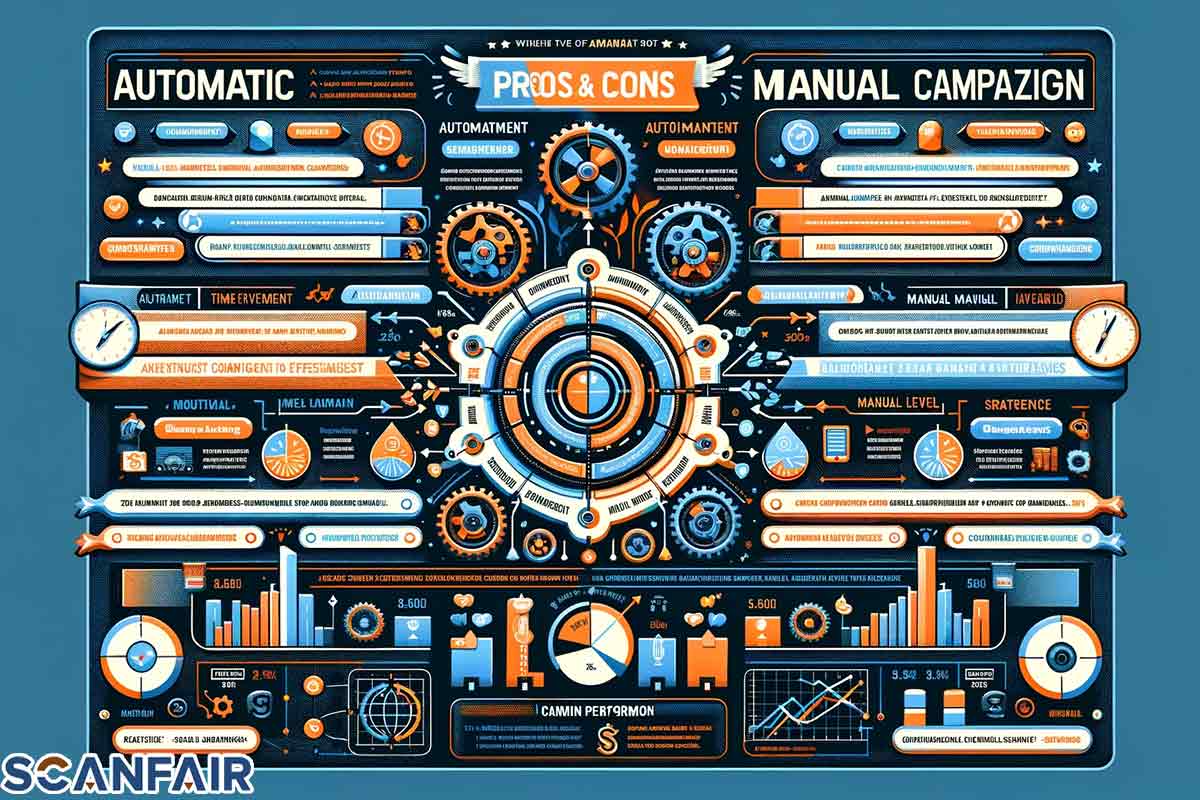In today’s digital marketplace, visibility on Amazon is not just an advantage; it’s a necessity for survival and success. Amazon Advertising emerges as a powerful tool, offering sellers the opportunity to amplify their product visibility through targeted ads. Among the pivotal decisions Amazon sellers face is choosing between Automatic and Manual Campaigns for their advertising efforts. This choice significantly impacts their strategy, budget, efficiency, and sales performance. Automatic campaigns allow Amazon’s algorithms to target ads based on product information, providing a hands-off approach for sellers. In contrast, manual campaigns offer sellers precise control over keyword targeting, allowing for more tailored ad placements. Understanding the nuances of each option is crucial for sellers aiming to maximize their return on investment and achieve optimal product visibility in Amazon’s competitive landscape. In the essay, we at Scan Fair will talk more about this topic.
Understanding the Basics
Amazon offers two main advertising campaign types: Automatic and Manual. Automatic Campaigns utilize Amazon’s algorithms to match your products with potential customer searches based on your product information, offering a hands-off advertising approach. This type is ideal for sellers new to Amazon advertising or those looking to discover new keywords. Manual Campaigns, in contrast, require sellers to select specific keywords and set bids for them, offering greater control over ad placement and targeting. This method suits sellers with a clear understanding of their target audience and preferred keywords.
What Are Automatic Campaigns on Amazon?
Automatic Campaigns on Amazon automatically target your ads to relevant searches based on product details. They simplify the advertising process, making it accessible and efficient, especially for uncovering new, effective keywords.
What Are Manual Campaigns on Amazon?
Manual Campaigns allow sellers to handpick keywords, control bids, and tailor their advertising strategy. This approach provides detailed targeting options, requiring more effort but offering precision and potential for higher efficiency.
Critical Differences Between Automatic and Manual Campaigns
The main differences lie in control, effort, and targeting precision. Automatic campaigns are easier to manage but offer less control, while manual campaigns demand more work but allow for specific targeting and potentially better ROI. Choosing between them depends on your advertising goals, experience, and willingness to invest time and time.
Deep Dive into Automatic Campaigns
Automatic Campaigns on Amazon leverage sophisticated algorithms to streamline the advertising process for sellers. By analyzing product listings, including titles, descriptions, and customer reviews, Amazon’s algorithm identifies keywords and search terms that potential customers might use, automatically targeting these for ad placements. This process reduces the need for sellers to conduct extensive keyword research, allowing them to focus on other aspects of their business while benefiting from Amazon’s vast customer base.
How Automatic Campaigns Work: The Algorithm Behind the Magic?
Amazon’s algorithm for Automatic Campaigns scans your product listings to select relevant keywords for ad placements. It continuously learns from the performance of these placements, adjusting targeting to improve ad efficiency over time. This dynamic approach ensures your ads remain competitive and visible to the right audience without constant manual intervention.
Pros of Automatic Campaigns: Ease of Use and Efficiency
The primary advantage of Automatic Campaigns is their simplicity and time-saving aspect. They require minimal setup and ongoing management, making them ideal for sellers needing more time or expertise for detailed keyword research. Additionally, these campaigns can uncover valuable keywords that sellers might not have considered, potentially increasing visibility and sales.
Cons of Automatic Campaigns: Less Control Over Targeting
While Automatic Campaigns offer convenience, they also have a significant drawback: reduced control over ad targeting. Since the algorithm selects keywords based on product information, sellers cannot specify which keywords to target or avoid. This can sometimes lead to ads appearing for less relevant searches, potentially reducing the effectiveness of your advertising spend.
Exploring Manual Campaigns
Manual Campaigns on Amazon allow sellers to influence their ad campaigns and bidding strategies directly. This hands-on approach allows for targeting specific keywords or products, offering precision and customization not available in automatic campaigns. Sellers can set custom bids for each keyword, giving them control over their ad spend and placement, leading to a more tailored advertising experience and potentially higher returns on investment.
The Mechanism of Manual Campaigns: A Closer Look
In Manual Campaigns, sellers conduct keyword research to identify the most relevant and profitable product keywords. They then manually select these keywords, set bids for each, and monitor performance to make adjustments as needed. This process allows for detailed targeting, enabling sellers to focus their efforts on keywords most likely to convert into sales.
Advantages of Manual Campaigns: Precision and Flexibility
The main advantages of Manual Campaigns include the precision of targeting and the flexibility to adjust bids and keywords based on performance. Sellers can target niche markets or specific customer segments, optimizing their ad spend for the best possible ROI. This approach also allows quick adjustments to market changes or campaign performance data.
Manual Campaigns: High Time & Complexity
The significant disadvantages of Manual Campaigns are the time investment required for setup and ongoing management and the complexity of optimizing campaigns. To maintain campaign effectiveness, sellers must invest time in keyword research, continuous monitoring, and bid adjustments. This can be a challenge for those who need more time or expertise in digital marketing, making Manual Campaigns less appealing to some Amazon sellers.
Comparative Analysis
Understanding their performance metrics, cost implications, and real-world outcomes is crucial when deciding between Automatic and Manual Campaigns on Amazon. A comparative analysis reveals the strengths and weaknesses of each approach, guiding sellers in making informed decisions that align with their business objectives and resources.
Performance Metrics: Automatic vs. Manual Campaigns Compared
Automatic Campaigns excel in ease of use and the discovery of new, relevant keywords, potentially leading to a broader reach. Manual Campaigns, however, offer higher precision in targeting, which can result in better conversion rates for those with the expertise to manage them effectively. The choice between the two often depends on the campaign’s specific goals, such as brand awareness versus targeted sales.
Cost Implications: Analyzing the ROI of Both Campaign Types
Automatic Campaigns may lead to higher spending due to less targeted ad placements, but they can also uncover previously overlooked profitable keywords. With their targeted approach, Manual Campaigns often provide a better ROI for those who invest time in keyword optimization and bid management. Balancing cost against potential returns is critical in choosing the right campaign type.
Case Studies: Real-World Successes and Lessons Learned
Examining case studies of both Automatic and Manual Campaigns can provide valuable insights. For example, a seller using Automatic Campaigns might discover unexpected keywords that drive sales, while a seller focusing on Manual Campaigns might achieve a higher ROI through precise targeting and bid adjustments. Learning from these real-world applications can help sellers optimize their advertising strategy on Amazon.
Strategic Considerations
Choosing between Automatic and Manual Campaigns on Amazon requires strategic consideration of your business goals, resources, and the specific circumstances of your market. Understanding when to use each campaign type—or a combination of both—can significantly enhance your advertising effectiveness and overall sales performance on Amazon.
When to Use Automatic Campaigns: Scenarios and Strategies
Automatic Campaigns are best utilized when you’re new to Amazon advertising, seeking to explore keyword opportunities without extensive market knowledge, or have a broad product range and want to capture a wide audience. They’re also ideal for those looking to save time on campaign management while benefiting from Amazon’s vast search data to uncover hidden keyword gems.
Choosing Manual Campaigns: Key Situations
Manual Campaigns are suited for sellers with a clear understanding of their target market, specific keywords in mind, and the desire for precise control over their ad spend. They’re particularly effective when targeting niche markets or when you can monitor and adjust optimization campaigns closely.
Combining Automatic and Manual Campaigns for Optimal Results
Consider running both Automatic and Manual Campaigns simultaneously for the best of both worlds. This strategy allows you to harness automatic campaigns’ broad reach and discovery potential while using the insights gained to refine and target your manual campaign efforts more effectively. This dual approach can optimize your visibility, efficiency, and ROI on Amazon’s competitive platform.
Expert Tips and Best Practices
Navigating Amazon’s advertising platform successfully requires a blend of strategic insight, ongoing optimization, and the effective use of tools. Drawing from the wisdom of industry experts, we’ve compiled essential tips and best practices to elevate your campaign management, avoid common pitfalls, and leverage innovative technologies for enhanced performance.
Mastering Campaign Management: Tips from Industry Experts
Experts recommend a data-driven approach to campaign management, emphasizing the importance of regular review and adjustment based on performance analytics. Diversifying your strategy to include automatic and manual campaigns can also capture a broader keyword spectrum and refine targeting precision over time. Tailoring your bids according to product life cycle stages and seasonal trends is crucial for maintaining competitive advantage.
Avoiding Common Pitfalls in Campaign Selection and Execution
A common mistake is neglecting negative keyword lists, which can prevent wasteful spending on irrelevant traffic. Overlooking ad scheduling and failing to adjust bids based on performance data can also diminish ROI. Regularly updating your campaigns to reflect inventory changes and market trends is essential for sustained success.
Innovative Tools and Software to Enhance Campaign Performance
Leveraging tools like keyword research software, bid management platforms, and analytics suites can significantly enhance the effectiveness of your Amazon campaigns. These technologies offer deeper insights into market trends, competitor strategies, and customer behavior, enabling more informed decision-making and streamlined campaign optimization.
Conclusion
Choosing between Automatic and Manual Campaigns on Amazon hinges on your specific goals, resources, and level of expertise in digital advertising. Automatic campaigns offer simplicity and a broad reach, making them ideal for newcomers or those seeking new keywords. Manual campaigns provide precision and control suited for experienced sellers focused on maximizing ROI through targeted advertising. By understanding the nuances of each and leveraging a combination of both, sellers can effectively enhance their visibility and sales on Amazon. Embracing continuous learning and adaptation is critical to successfully navigating the dynamic landscape of Amazon advertising.



